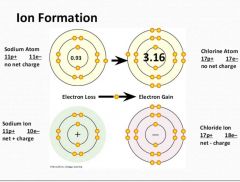![]()
![]()
![]()
Use LEFT and RIGHT arrow keys to navigate between flashcards;
Use UP and DOWN arrow keys to flip the card;
H to show hint;
A reads text to speech;
9 Cards in this Set
- Front
- Back
|
What is a chemical bond? |
An attractive to life between two atoms (the electrons of one atom are attracted to the nucleus of the other atom) that holds them together and makes them function as a unit. |
|
|
What is ionization energy? |
The amount of energy required to remove the most loosely bound electron (valence electron) from an isolated gas-phase atom to form a cation. |
|
|
What is electronegativity? |
A measure of an atoms ability to attract electrons from other atoms towards itself. |
|
|
What does electronegativitty depend on? |
Atoms size & Number of valence electrons |
|
|
From left to right on the period table, electronegativity tends to ________. |
Increase |
|
|
Illustrate ion formation |

|
|
|
Describe ionic bonding. |
Two atoms of opposite charge with a relatively Large Difference in Electronegativity (≤1.7) transfer electrons to get positively charged cations (lost electrons) and negatively charged anions (gained electrons). |
|
|
An electronegativitty difference greater than ____ will likely lead to an ionic bond. |
1.7 |
|
|
Is the sodium chloride bond covalent or ionic? |
Na = 0.93 Cl = 3.16 Difference is 3.16 – 0.93 = 2.23 Ionic Bond likely if the difference is greater than 1.7Therefore, the Sodium–Chloride Bond (interaction) is Ionic |

